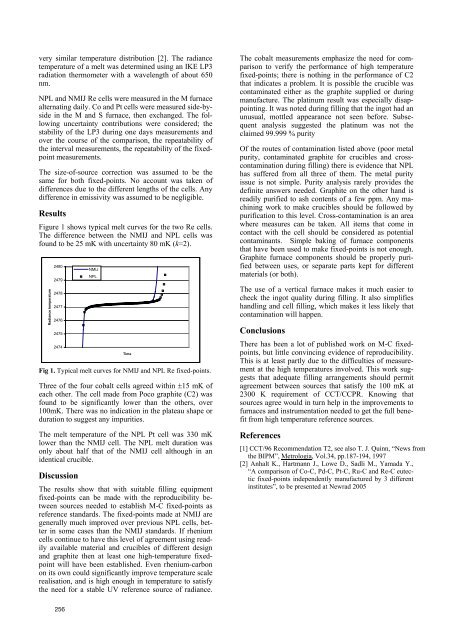Here - PMOD/WRC
Here - PMOD/WRC
Here - PMOD/WRC
You also want an ePaper? Increase the reach of your titles
YUMPU automatically turns print PDFs into web optimized ePapers that Google loves.
very similar temperature distribution [2]. The radiance<br />
temperature of a melt was determined using an IKE LP3<br />
radiation thermometer with a wavelength of about 650<br />
nm.<br />
NPL and NMIJ Re cells were measured in the M furnace<br />
alternating daily. Co and Pt cells were measured side-byside<br />
in the M and S furnace, then exchanged. The following<br />
uncertainty contributions were considered; the<br />
stability of the LP3 during one days measurements and<br />
over the course of the comparison, the repeatability of<br />
the interval measurements, the repeatability of the fixedpoint<br />
measurements.<br />
The size-of-source correction was assumed to be the<br />
same for both fixed-points. No account was taken of<br />
differences due to the different lengths of the cells. Any<br />
difference in emissivity was assumed to be negligible.<br />
Results<br />
Figure 1 shows typical melt curves for the two Re cells.<br />
The difference between the NMIJ and NPL cells was<br />
found to be 25 mK with uncertainty 80 mK (k=2).<br />
Radiance temperature<br />
2480<br />
2479<br />
2478<br />
2477<br />
2476<br />
2475<br />
2474<br />
Fig 1. Typical melt curves for NMIJ and NPL Re fixed-points.<br />
Three of the four cobalt cells agreed within ±15 mK of<br />
each other. The cell made from Poco graphite (C2) was<br />
found to be significantly lower than the others, over<br />
100mK. There was no indication in the plateau shape or<br />
duration to suggest any impurities.<br />
The melt temperature of the NPL Pt cell was 330 mK<br />
lower than the NMIJ cell. The NPL melt duration was<br />
only about half that of the NMIJ cell although in an<br />
identical crucible.<br />
Discussion<br />
NMIJ<br />
NPL<br />
Time<br />
The results show that with suitable filling equipment<br />
fixed-points can be made with the reproducibility between<br />
sources needed to establish M-C fixed-points as<br />
reference standards. The fixed-points made at NMIJ are<br />
generally much improved over previous NPL cells, better<br />
in some cases than the NMIJ standards. If rhenium<br />
cells continue to have this level of agreement using readily<br />
available material and crucibles of different design<br />
and graphite then at least one high-temperature fixedpoint<br />
will have been established. Even rhenium-carbon<br />
on its own could significantly improve temperature scale<br />
realisation, and is high enough in temperature to satisfy<br />
the need for a stable UV reference source of radiance.<br />
The cobalt measurements emphasize the need for comparison<br />
to verify the performance of high temperature<br />
fixed-points; there is nothing in the performance of C2<br />
that indicates a problem. It is possible the crucible was<br />
contaminated either as the graphite supplied or during<br />
manufacture. The platinum result was especially disappointing.<br />
It was noted during filling that the ingot had an<br />
unusual, mottled appearance not seen before. Subsequent<br />
analysis suggested the platinum was not the<br />
claimed 99.999 % purity<br />
Of the routes of contamination listed above (poor metal<br />
purity, contaminated graphite for crucibles and crosscontamination<br />
during filling) there is evidence that NPL<br />
has suffered from all three of them. The metal purity<br />
issue is not simple. Purity analysis rarely provides the<br />
definite answers needed. Graphite on the other hand is<br />
readily purified to ash contents of a few ppm. Any machining<br />
work to make crucibles should be followed by<br />
purification to this level. Cross-contamination is an area<br />
where measures can be taken. All items that come in<br />
contact with the cell should be considered as potential<br />
contaminants. Simple baking of furnace components<br />
that have been used to make fixed-points is not enough.<br />
Graphite furnace components should be properly purified<br />
between uses, or separate parts kept for different<br />
materials (or both).<br />
The use of a vertical furnace makes it much easier to<br />
check the ingot quality during filling. It also simplifies<br />
handling and cell filling, which makes it less likely that<br />
contamination will happen.<br />
Conclusions<br />
There has been a lot of published work on M-C fixedpoints,<br />
but little convincing evidence of reproducibility.<br />
This is at least partly due to the difficulties of measurement<br />
at the high temperatures involved. This work suggests<br />
that adequate filling arrangements should permit<br />
agreement between sources that satisfy the 100 mK at<br />
2300 K requirement of CCT/CCPR. Knowing that<br />
sources agree would in turn help in the improvements to<br />
furnaces and instrumentation needed to get the full benefit<br />
from high temperature reference sources.<br />
References<br />
[1] CCT/96 Recommendation T2, see also T. J. Quinn, “News from<br />
the BIPM”, Metrologia, Vol.34, pp.187-194, 1997<br />
[2] Anhalt K., Hartmann J., Lowe D., Sadli M., Yamada Y.,<br />
“A comparison of Co-C, Pd-C, Pt-C, Ru-C and Re-C eutectic<br />
fixed-points independently manufactured by 3 different<br />
institutes”, to be presented at Newrad 2005<br />
256
















